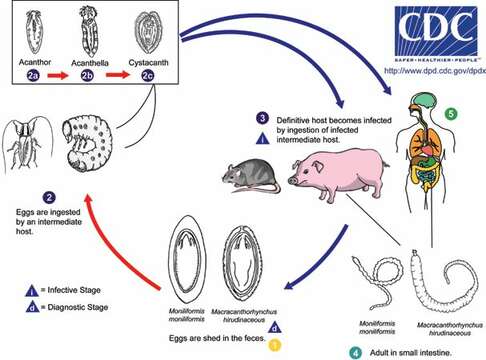Life cycle of acanthocephalans Moniliformis moniliformis and Macracanthorhynchus hirudinaceus

Опис:
Life cycle of acanthocephalans Moniliformis moniliformis and Macracanthorhynchus hirudinaceus
Eggs are shed in the feces of the definitive hosts (1), which are usually rats in the case of M. moniliformis and swine for M. hirudinaceous, although carnivores and primates, including humans, may serve as accidental hosts. The eggs contain a fully-developed acanthor when shed in feces. The eggs are ingested by an insect intermediate host (2) (usually scarabaeoid or hydrophilid beetles for M. hirudinaceus and beetles or cockroaches for M. moniliformis). Within the hemocoelom of the insect, the acanthor (2a) molts into a second larval stage, called an acanthella (2b). After 6-12 weeks, the worm reaches the infective stage called a cystacanth (2c). The definitive host becomes infected upon ingestion of intermediate hosts containing infective cystacanths (3). In the definitive host, liberated juveniles attach to the wall of the small intestine, where they mature (4) and mate in about 8-12 weeks. In humans (5), the worms seldom mature, or mature but will rarely produce eggs.
From Centers for Disease Control Parasites and Health website
Се јавува на следниве страници:
- Life
- Cellular
- Eukaryota (еукариот)
- Opisthokonta
- Metazoa
- Bilateria
- Protostomia
- Spiralia
- Gnathifera
- Syndermata
- Acanthocephala
- Archiacanthocephala
- Moniliformida
- Moniliformidae
- Moniliformis
- Moniliformis moniliformis
Сликата ја нема во ниедна збирка.
Информации за изворот
- лиценца
- cc-by-nc
- авторски права
- Centers for Disease Control/Division of Parasitic Diseases and Malaria
- објавил
- Shapiro, Leo
- фотограф
- Centers for Disease Control/Division of Parasitic Diseases and Malaria
- добавувач
- EOL Rapid Response Team
- изворно
- изворна податотека
- посети извор
- соработничко мреж. место
- EOL staff
- ID


